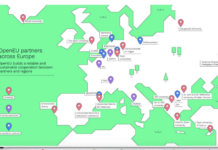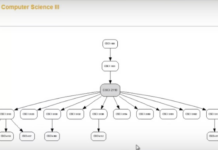McCrea, B. (2009) 5 Higher Ed Trends to Watch in 2010 Campus Technology, December 9
Here is the first of the predictions for educational technology trends for 2010. If this is the way of the future, frankly I give up. We should just stop trying to use technology in higher education, and give the money to poor kids in Africa to buy themselves something useful.
Here are Campus Computing’s five trends (with quotations from the article in italics):
1. Interactive classrooms: “Anything that helps make the classroom more interactive, animated and engaging–be it multimedia, streaming video or some other innovation–will be in demand this year.” What next? Lecturers dressed as clowns, doing juggling? Come on, guys, the space-based lecture classroom is DEAD (actually, a zombie, as it’s really still the living dead).
2. Information at your fingertips. “In an era when information just can’t be produced quickly enough, electronic book readers, smart phones, search engines, and other tools will continue to create an educational environment where both students and teachers have everything they need at their fingertips.” OK so far. Then it goes on to say: ‘Phelan pointed to the colleges that are “handing out” tablet PCs to all freshmen as the frontrunners in the race to equip students with all of the information they need to succeed in school. “I’d really like to see more schools making that move,” said Phelan, “and even further integrate technology into the college classroom.” Why? If they have this stuff, why bring it to class? YOU HAVE TO RE-DESIGN YOUR TEACHING – OR RATHER THE LEARNING ENVIRONMENT – TO BENEFIT FROM THIS, NOT CHAIN IT TO THE CLASSROOM!
3. Mashed up technologies ‘“Students are using every communication vector that they can get their hands on right now,” said Ron Hutchins, associate vice provost for research technology and CTO at Georgia Institute of Technology’s Office of Information Technology. “It just makes sense that they would mash those technologies together and make them more specific and customizable.” OK – I have no problem with this one, except I’d like to see some ideas of how this is to be integrated within the curriculum to address educational issues, and in particular how this will be related to developing 21st century skills within a particular knowledge domain. Getting students to mash up is the easy part; the hard part is asking the questions: ‘To what purpose?’ and ‘how effective is it in supporting learning?’
4. Breaking Out of Technology Isolation “One of the coolest uses of technology that Hutchins has seen lately can be found in Rutgers University’s English department, which is equipped with an entire wall of touch-enabled whiteboards. Using precision positioning technology, the wall-mounted boards allow for unprecedented participation and collaboration among students. “Students walk up to the wall and use their hands to manipulate items,” remarked Hutchins. “It’s like putting your whole body into a design project.” Hutchins said such innovations also go a long way in getting students up out of their seats and interacting with educators, other students and technology in a meaningful way. “Technology can be isolating,” he said. “I love the notion of integrating the classroom and making it more social. This is just one way to make that happen.” Well, if you want to make technology less isolating, why not use online collaborative learning, social software, or just provide students a time and/or place, physical or virtual, to talk? Touching whiteboards on walls to break down technology isolation? Give me a break.
5. Capabilities That Go Beyond 1:1 Netbooks, online education, social networking, smart phones and podcasting will continue to play a role in the typical student’s life, as will “4:1 computing” as a replacement for the more traditional 1:1 (one device to handle one task). Well, what about technology integration? I don’t think the trend is to more devices, but one device that does everything. So NO, the trend will be MORE to 1:1 – one student, one device – computer, mobile phone, TV, e-book, search engine, camera, recording studio, GPS system, transmitter, and many more functions we haven’t even though of yet – all on one device.
I suppose that a journal called CAMPUS Technology cannot think outside the classroom or the campus. What should be remembered though is that the classroom and the campus are the technology of face-to-face teaching for an industrial society. What we need to think about is the appropriate cyberspace technologies and learning environments for an information society. Like all old technologies, the physical classroom still has a niche role in education, but we need to be thinking of that niche role as an ancillary of digital learning, not the core of our focus.
In a few days time, I will be doing my own predictions for 2010, so you will be able to mock my efforts! Well, that’s only fair, isn’t it?









 Dr. Tony Bates is the author of eleven books in the field of online learning and distance education. He has provided consulting services specializing in training in the planning and management of online learning and distance education, working with over 40 organizations in 25 countries. Tony is a Research Associate with Contact North | Contact Nord, Ontario’s Distance Education & Training Network.
Dr. Tony Bates is the author of eleven books in the field of online learning and distance education. He has provided consulting services specializing in training in the planning and management of online learning and distance education, working with over 40 organizations in 25 countries. Tony is a Research Associate with Contact North | Contact Nord, Ontario’s Distance Education & Training Network.


I keep seeing interactive lessons in action via my job… One chap who has been picked on moving some stuff around on the interactive board whilst the others look on… Fortunately death by power point quickly takes over. Or everyone accesses the lesson content via google sites and the teacher goes from one pc to another explaining what the instructions mean. Technology is allowing too many teachers to move their eyes off the ball and rely on their technical expertise to pretend it is akin to teaching expertise! Keep those rants going!
[…] https://tonybates.wpengine.com/2009/12/12/5-higher-ed-trends-not-to-watch-in-2010/ […]
Re: #4 Never mind that IWB technologies often don’t work as well as the mental image. And if (and that’s a big if) these are tools to break down social isolation, the same student that doesn’t raise their hands aren’t going to be the ones that go up to a whiteboard to “interact”.
On top of that, IWB’s that seek to break down social isolation would have to be multi-touch interfaces as a starter.
Tony
I couldn’t agree more! We see so many institutions shoe-horning technology into old-fashioned rooms and pedagogies – and then when it is a disaster, they blame the technology, suggesting that the ‘old way’ probably was better…
Changing teaching practices is so much harder than installing a machine!
Looking forward to your predictions!
Ian
(PS Greetings from sunny Australia!)
Ya’know, having seen technologies come and go for a very very long time in education, I can’t help wondering why everyone missed the fact that the single best thing to help students learn is having a good teacher. Period. Full Stup. Etc.
Now this comes from a guy how had made most of his adult living designing and installing “technology” in classrooms. Remember when tape recording language labs were going to make teaching language a new miracle?
Maybe, instead of pushing money into gizmo’s that “might” help learning, that money would be better spent on finding instructors (with or without Phds) that can actually teach, and pay them enough that they can spend the time on campus (or online) that it takes to make the connections necessary.
All I see is more money going to a few big name, highly published faculty (who are there only to do their own research), some of the better junior instructors laid off and replaced by third rate adjuncts who spend possibly 10 minutes more with the students than they are mandated to in the classroom so they can get to one of the other 5 schools they have to teach at in order to make their bills, and more technology experts and developers whom of course need even more administrators and specialty deans which cost more than any new fangled hi-tech room ever will. While not adding to the support people needed to keep the whole darn thing running.
[…] teaching into technology I’ve been reading Tony Bates’ blog post 5 higher ed trends not to watch in 2010, his reaction to 5 higher ed tech trends to watch in 2010 at Campus Technology. A couple of his […]
Everyone has their favorite way of using the internet. Many of us search to find what we want, click in to a specific website, read what’s available and click out. That’s not necessarily a bad thing because it’s efficient. We learn to tune out things we don’t need and go straight for what’s essential.
Technology…what ever happened to the “old way” of teaching. Is it just me or is everyone, including students and teachers, simply looking for the fast and easy route. I understand that technology has improved life for the most part but I believe it has poked it’s nose way to far into a the learning enviroment. Just my two cents.
Thank you